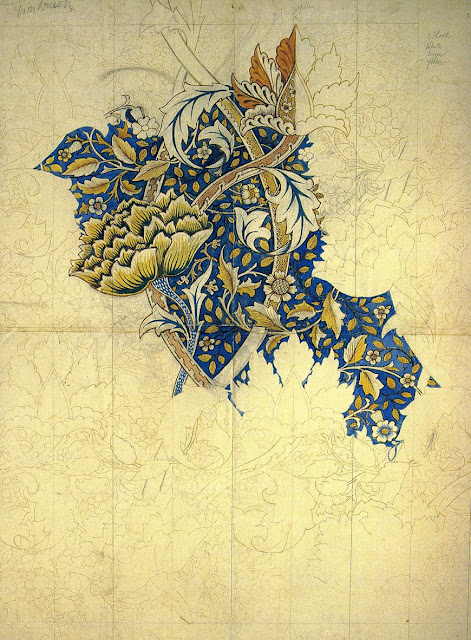William Morris is undoubtedly England's most famous nineteenth century textile designer. So much has been written about him over the decades, that it seems as if there is little more to add. However, there is an interesting viewpoint of Morris's work that needs explaining and that is his innate and longstanding love of nature, which was always to be the central spine of all of his design output. What nature actually meant to Morris on a personal and emotional level is probably as important, if not more so, than its use in his decorative career.
Morris love of nature was rooted in the idea that the natural world could be the only real and constant in a world of Victorian industrial and technological upheaval and change. Many observers of nineteenth century England were dismayed by the pace of that change within society and the landscape and were disturbed by what it was in the process of doing, literally and irrevocably changing the face of England.
The change in society, in particular, is an important point. Many of the critics of industrial England like Morris came from a wealthy or at least comfortable social background. Many of these people were rooted in the idea of the continuity of society and the importance of the inheritance and maintenance of land. The top layers of English society very often saw themselves as the feudal landlords of an unchanging rural landscape which was seen to be being dismantled by the industrial machine that was modern England.
Illustration: William Morris, 1887.
Morris was part of the wide-ranging Arts and Crafts movement. This movement was overall, run by benevolent middle class socialists, who saw the honest worker as in need of a helping hand to retrieve his confidence and self-worth through the dignity of labour. It was thought that through this process the worker would once again see himself as an integral part of the community rather than a nameless pawn used by the capitalist system. On the surface this was indeed, a worthy exercise.
However, it is interesting to note that very few of the pioneering Arts and Crafts reformers, from John Ruskin, through William Morris to the younger generations that followed, seemed aware that the honest worker might actually have an opinion or voice of their own. These organizations were largely benevolent and parental in makeup. There was very little room, if any, for the input of the worker.
Morris saw nature as his constant. Nature was traditional and unchanging. However, tradition can also imply both constraint and inflexibility. If Morris had been able to transform society from industrial capitalism back to traditional rural feudalism, he would have. What Morris and his supporters failed to recognise was the fact that despite the fact that the standard of living of the average industrial worker was abysmal, the standard of living of the average rural worker was far worse.
It could perhaps be seen as a blind spot amongst many of the Arts and Crafts purveyors who wished to see the ideal of a medieval and rural England. It was deemed that traditional rural workers were happy with their lot because they were still living with the constant traditions of an ageless England that could trace its rural history back to the medieval period and beyond. The dream Morris and his fellow Arts and Crafts organisers had was that of a medieval world that was peopled by happy serfs who had pride in their work, but stayed where they were socially. However, the medieval world was both hierarchical and maternalistic with very few individuals being able to make any formal decisions about the running of their own lives and that of their families. Morris was well aware that in this happy medieval world, he and others like him would effectively be put in charge.
This may be a little harsh on Morris. He genuinely believed that the Victorian system was rotten to the core and had to be changed. As he got older, he genuinely came to the belief that change could only take place through what in effect would have been a violent workers revolution on the scale of the Russian in 1917. However, whether or not a benevolent hierarchical and maternalistic framework would have been constructed after the revolution, on the scale of the mediaeval period, is unknown. More importantly for Morris himself, how his company Morris & Co, which supplied the wealthy classes with work produced in the main by his honest workers, was to fair in this post-revolutionary world, is anyone's guess.






